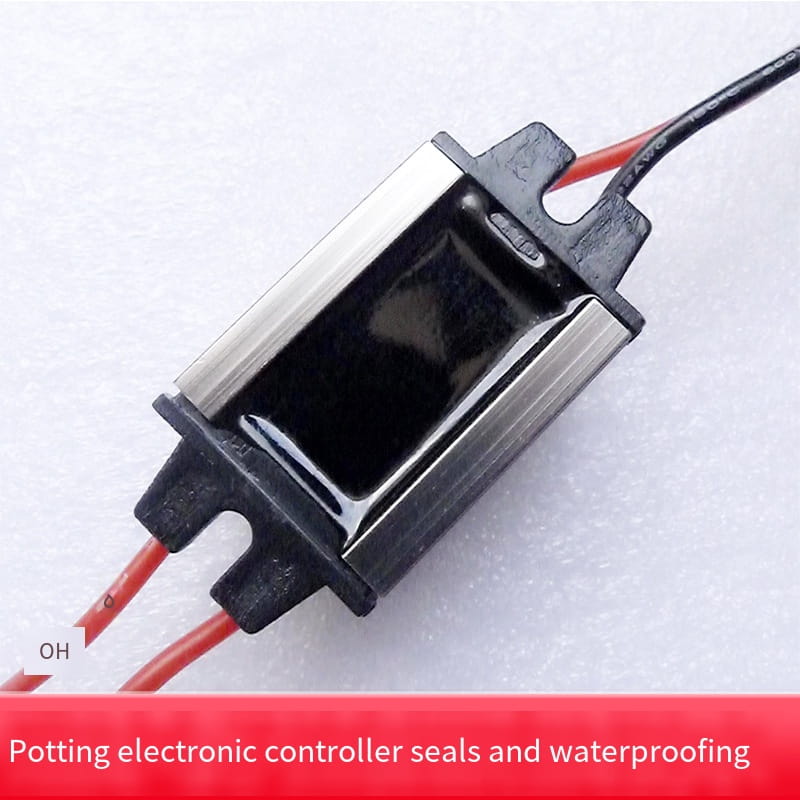Common problems with potting adhesive - factors that affect the appearance of potting adhesive?
 Jan 29,2024
Jan 29,2024

 Hanast
Hanast
Bubbles, uneven wrinkles, and oil on the surface of the potting adhesive are all appearance issues. Next, HANAST will work with you to understand why these appearance issues occur with the potting adhesive.
1. Bubbles and voids:
Factors: Improper stirring or mixing processes, high humidity environments, and rapid curing rates can all lead to the formation of bubbles and voids.
Solution:
▶ Stir thoroughly: Ensure that the resin and curing agent are thoroughly mixed to avoid the introduction of bubbles.
▶ Vacuum treatment: Use vacuum equipment during mixing and sealing to help remove bubbles introduced during stirring.
▶ Control humidity: When working in high-humidity environments, use humidity control equipment to ensure that materials are not affected by moisture during preparation and application.
2. Color difference and whitening phenomenon:
Factors: Different batches of materials, different process conditions, and prolonged exposure to light may cause color differences or whitening of the sealing adhesive.
Solution:
▶ Using the same batch of materials: Ensure that the same batch of resins and curing agents are used during the production process.
▶ Control lighting conditions: Avoid prolonged exposure of sealing adhesive to sunlight, or choose sealing adhesive with good UV resistance.
3. Unsmooth or defective surface:
Factors: contamination during the preparation process, uneven coating, improper control of process parameters, etc. may lead to surface roughness or defects.
Solution:
▶ Control the preparation environment: Ensure that the preparation area is clean and avoid unnecessary contamination of the sealing adhesive.
▶ Adjust coating process parameters: Adjust coating speed, pressure, and other parameters to ensure uniform coating.
▶ Regular inspection and cleaning of coating equipment: Ensure that the equipment is free of dust and impurities.
4. Color change:
Factors: Material exposure time, prolonged exposure to light, chemical corrosion, and other factors may cause color changes.
Solution:
▶ Choose a sealing adhesive with strong light resistance.
▶ When necessary, use additives to enhance the chemical resistance of the sealing adhesive.
▶ In applications with harsh environmental conditions, choose potting adhesive with good color stability.
5. Incomplete or excessive curing:
Factors: Inaccurate mixing ratio, improper temperature control, high or low humidity, etc. may lead to incomplete or excessive curing.
Solution:
▶ Ensure accurate mixing ratio and use appropriate resin and curing agent ratios according to the manufacturer's recommendations.
▶ Control the curing temperature and humidity to ensure curing is carried out under suitable environmental conditions.
▶ Select the appropriate hardness sealing adhesive according to production needs.
6. Viscosity control:
Factor: Differences in viscosity may lead to issues such as uneven coating and insufficient filling.
Solution:
▶ Before coating, adjust the viscosity of the sealing adhesive according to production needs.
▶ Choose a low-viscosity potting adhesive suitable for the coating process.
7. Chemical resistance:
Factor: In some chemical environments, the sealing adhesive may be chemically corroded, leading to appearance issues.
Solution:
▶ Select sealing adhesive with strong chemical resistance according to the application environment.
▶ Take measures in environments that may be subject to chemical corrosion, such as adding anti chemical agents.
8. Environmental factor control:
Factors: temperature and humidity during the preparation process, environmental conditions after the application of sealing adhesive, etc.
Solution:
▶ Control the temperature and humidity of the production environment to ensure preparation is carried out under suitable conditions.
▶ In the product usage environment, consider environmental factors in advance and choose a sealing adhesive that is suitable for a specific environment.
9. Quality inspection and monitoring:
Factor: Lack of quality inspection and monitoring may lead to problems not being detected and addressed promptly.
Solution:
▶ Establish a comprehensive quality inspection system and conduct testing on each batch of sealing adhesive.
▶ Use a monitoring system during the production process to monitor key parameters in real-time, detect anomalies promptly, and make adjustments.




 Home
Home





 Why do components need to be sealed?
Why do components need to be sealed?  You May Also Like
You May Also Like







 Tel
Tel
 Email
Email
 Address
Address












